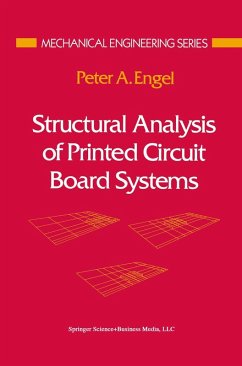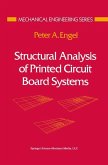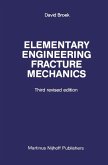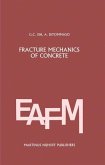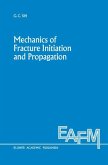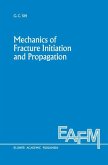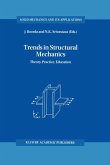Peter A. Engel
Structural Analysis of Printed Circuit Board Systems
Peter A. Engel
Structural Analysis of Printed Circuit Board Systems
- Gebundenes Buch
- Merkliste
- Auf die Merkliste
- Bewerten Bewerten
- Teilen
- Produkt teilen
- Produkterinnerung
- Produkterinnerung
Main description:
This book discusses the building blocks of electronic circuits - the microchips, transistors, resistors, condensers, and so forth, and the boards that support them - from the point of view of mechanics: What are the stresses that result from thermal expansion and contraction? What are the elastic parameters that determine whether a component will survive a certain acceleration? After an introduction to the elements of structural analysis and finite-element analysis, the author turns to components, data and testing. A discussion of leadless chip carriers leads to a detailed…mehr
Andere Kunden interessierten sich auch für
![Structural Analysis of Printed Circuit Board Systems Structural Analysis of Printed Circuit Board Systems]() Peter A. EngelStructural Analysis of Printed Circuit Board Systems115,99 €
Peter A. EngelStructural Analysis of Printed Circuit Board Systems115,99 €![Elementary engineering fracture mechanics Elementary engineering fracture mechanics]() D. BroekElementary engineering fracture mechanics109,99 €
D. BroekElementary engineering fracture mechanics109,99 €![Fracture mechanics of concrete: Structural application and numerical calculation Fracture mechanics of concrete: Structural application and numerical calculation]() G.C. Sih / A. Ditomasso (Hgg.)Fracture mechanics of concrete: Structural application and numerical calculation153,99 €
G.C. Sih / A. Ditomasso (Hgg.)Fracture mechanics of concrete: Structural application and numerical calculation153,99 €![Solid mechanics research for quantitative non-destructive evaluation Solid mechanics research for quantitative non-destructive evaluation]() J.D. Achenbach / Y. Rajapakse (Hgg.)Solid mechanics research for quantitative non-destructive evaluation153,99 €
J.D. Achenbach / Y. Rajapakse (Hgg.)Solid mechanics research for quantitative non-destructive evaluation153,99 €![Mechanics of Fracture Initiation and Propagation Mechanics of Fracture Initiation and Propagation]() George C. SihMechanics of Fracture Initiation and Propagation115,99 €
George C. SihMechanics of Fracture Initiation and Propagation115,99 €![Mechanics of Fracture Initiation and Propagation Mechanics of Fracture Initiation and Propagation]() George C. SihMechanics of Fracture Initiation and Propagation115,99 €
George C. SihMechanics of Fracture Initiation and Propagation115,99 €![Trends in Structural Mechanics Trends in Structural Mechanics]() J. Roorda / N.K. Srivastava (Hgg.)Trends in Structural Mechanics153,99 €
J. Roorda / N.K. Srivastava (Hgg.)Trends in Structural Mechanics153,99 €-
-
-
Main description:
This book discusses the building blocks of electronic circuits - the microchips, transistors, resistors, condensers, and so forth, and the boards that support them - from the point of view of mechanics: What are the stresses that result from thermal expansion and contraction? What are the elastic parameters that determine whether a component will survive a certain acceleration? After an introduction to the elements of structural analysis and finite-element analysis, the author turns to components, data and testing. A discussion of leadless chip carriers leads to a detailed thermal analysis of pin grid arrays. For compliant leaded systems, both mechanical (bending and twisting) and thermal stresses are discussed in detail. The book concludes with discussions of the dynamic response of circuit cards, plated holes in cards and boards, and the final assembly of cards and boards.
This book discusses the building blocks of electronic circuits - the microchips, transistors, resistors, condensers, and so forth, and the boards that support them - from the point of view of mechanics: What are the stresses that result from thermal expansion and contraction? What are the elastic parameters that determine whether a component will survive a certain acceleration? After an introduction to the elements of structural analysis and finite-element analysis, the author turns to components, data and testing. A discussion of leadless chip carriers leads to a detailed thermal analysis of pin grid arrays. For compliant leaded systems, both mechanical (bending and twisting) and thermal stresses are discussed in detail. The book concludes with discussions of the dynamic response of circuit cards, plated holes in cards and boards, and the final assembly of cards and boards.
Produktdetails
- Produktdetails
- Verlag: Springer New York / Springer US
- 1993
- Seitenzahl: 316
- Erscheinungstermin: 24. Juni 1993
- Englisch
- Abmessung: 241mm x 160mm x 22mm
- Gewicht: 641g
- ISBN-13: 9780387979397
- ISBN-10: 0387979395
- Artikelnr.: 21639175
- Herstellerkennzeichnung
- Springer-Verlag GmbH
- Tiergartenstr. 17
- 69121 Heidelberg
- ProductSafety@springernature.com
- Verlag: Springer New York / Springer US
- 1993
- Seitenzahl: 316
- Erscheinungstermin: 24. Juni 1993
- Englisch
- Abmessung: 241mm x 160mm x 22mm
- Gewicht: 641g
- ISBN-13: 9780387979397
- ISBN-10: 0387979395
- Artikelnr.: 21639175
- Herstellerkennzeichnung
- Springer-Verlag GmbH
- Tiergartenstr. 17
- 69121 Heidelberg
- ProductSafety@springernature.com
1. Elements of Structural Analysis.
1. Rods.
2. Beams.
3. Plates.
4. Thermal Stress.
5. Plastic Beam Deformation.
6. Energy Methods in Structural Analysis.
7. Experimental Methods of Analysis.
References.
2. Finite Element Analysis.
1. Preliminaries.
2. Direct Stiffness Matrix Approach.
3. The Principle of Minimum Potential Energy.
4. Element Types.
5. Finite Element Dynamic Analysis.
6. Stress and Strain Calculations.
7. Structural Codes.
8. Steps in the Use of Finite Element Analysis.
References.
3. Components, Data, and Testing.
1. Modules.
2. Circuit Cards and Boards.
3. Pin Leads of PGA Modules.
4. Strength of Compliant Leads in Surface
Mount Construction.
5. Stiffness of Compliant Leads.
6. Solder Strength.
References.
4. Leadless Chip Carriers.
1. Loads and Materials.
2. Thermal Stress Analysis.
3. The Influence of Solder Joint Shape.
4. Constitutive Equation for Solder Mount.
5. Conclusions.
6. Exercises and Questions.
References.
5. Thermal Stress in Pin
Grid Arrays: Primary Analysis of Pins.
1. Introduction.
2. Elastic Foundation Modulus of a Soldered Pin.
3. Elastic Foundation Treatment for the Embedded Pin.
4. Solder Pressure Calculation.
5. Plastic Analysis of the Pin.
6. Axial Pin Force Due to Flexure.
7. A Magnified
Scale Experiment.
8. Conclusions.
9. Exercises and Questions.
References.
6. Thermal Stress in Pin
Grid Arrays: Interaction Between Module and Circuit Card.
1. Pin Force Analysis Due to Module and Card Bending.
2. Influence of Pin
End Moments.
3. Influence of the Primary Axial Pin Forces.
4. Influence of Secondary Axial Pin Forces.
5. Solution of the System of Equations.
6. Module and Card Stretch Due to Pin Shear.
7. System Reduction Factor.
8. Conclusions.
9. Exercises and Questions.
References.
7. Compliant Leaded Systems: The Local Assembly.
1. Experimental Studies.
2. Analytical Model.
3. Properties of Simple Local Assemblies.
4. Discrete Local Assembly.
5. Built
up (Multiple
Module) Local Assemblies.
6. Orthotropy of Local Assemblies.
7. Module Group Assemblies.
8. Conclusions.
9. Exercises and Questions.
References.
8. Bending in Compliant Leaded Systems.
1. The Role of Leads.
2. Application of the Finite Element Method.
3. Strip Method.
4. Building Block Method.
5. Hybrid Experimental/Analytical Method.
6. Conclusions.
7. Exercises and Questions.
References.
9. Approximate Engineering Theory for the Twisting of Compliant Leaded Circuit Card/Module Systems.
1. Fundamental Approach.
2. Torsional Stiffness Calculation.
3. Rectangular Cards with a Module.
4. Module Clusters.
5. Finite Element Check of the Approximate Theory.
6. Conclusions.
7. Exercises and Questions.
References.
10. Analytical Theory and Experimental Work in Compliant Leaded Systems Subjected to Twisting.
1. Analytical Theory.
2. Torsional Stiffness.
3. Experimental Study.
4. Large Displacements.
5. Approximate Large Displacement Analysis of a Square Card.
6. Torsional Fatigue.
7. Conclusions.
8. Exercises and Questions.
References.
11. Thermal Stresses in Compliant Leaded Systems.
1. Motivation for Analysis.
2. Analytical Lead Stress Computation.
3. Finite Element Thermal Stress Analysis.
4. Stress Reduction in Compliant Leaded Solder Joints.
5. Thermal Fatigue in Solder Joints of Compliant Leads.
6. Thermal Cycling Reliability.
7. Exercises and Questions.
References.
12. Dynamic Response of Circuit Card Systems.
1. General Considerations.
2. Dynamic Load Levels and Measurement.
3. Vibration Analysis in Circuit Card Systems.
4.Transient Vibration and Shock Response.
5. Fatigue Considerations.
6. Conclusions.
7. Exercises and Questions.
References.
13. Plated Holes in Cards and Boards.
1. Introduction.
2. Thermal Stress from Module
to
Card Mismatch.
3. Thermal Stress from Barrel
to
Board Mismatch.
4. Experimental Methods.
5. Vias.
6. Conclusions.
7. Exercises and Questions.
References.
14. Assembly of Cards and Boards.
1. Physical Description.
2. ZIF Connector Actuation.
3. Connector Contact.
4. Dynamic Response.
5. Thermal Stress.
6. A Combined Permanent and Separable Connector System.
7. Conclusions.
8. Exercises and Questions.
References.
Author Index.
1. Rods.
2. Beams.
3. Plates.
4. Thermal Stress.
5. Plastic Beam Deformation.
6. Energy Methods in Structural Analysis.
7. Experimental Methods of Analysis.
References.
2. Finite Element Analysis.
1. Preliminaries.
2. Direct Stiffness Matrix Approach.
3. The Principle of Minimum Potential Energy.
4. Element Types.
5. Finite Element Dynamic Analysis.
6. Stress and Strain Calculations.
7. Structural Codes.
8. Steps in the Use of Finite Element Analysis.
References.
3. Components, Data, and Testing.
1. Modules.
2. Circuit Cards and Boards.
3. Pin Leads of PGA Modules.
4. Strength of Compliant Leads in Surface
Mount Construction.
5. Stiffness of Compliant Leads.
6. Solder Strength.
References.
4. Leadless Chip Carriers.
1. Loads and Materials.
2. Thermal Stress Analysis.
3. The Influence of Solder Joint Shape.
4. Constitutive Equation for Solder Mount.
5. Conclusions.
6. Exercises and Questions.
References.
5. Thermal Stress in Pin
Grid Arrays: Primary Analysis of Pins.
1. Introduction.
2. Elastic Foundation Modulus of a Soldered Pin.
3. Elastic Foundation Treatment for the Embedded Pin.
4. Solder Pressure Calculation.
5. Plastic Analysis of the Pin.
6. Axial Pin Force Due to Flexure.
7. A Magnified
Scale Experiment.
8. Conclusions.
9. Exercises and Questions.
References.
6. Thermal Stress in Pin
Grid Arrays: Interaction Between Module and Circuit Card.
1. Pin Force Analysis Due to Module and Card Bending.
2. Influence of Pin
End Moments.
3. Influence of the Primary Axial Pin Forces.
4. Influence of Secondary Axial Pin Forces.
5. Solution of the System of Equations.
6. Module and Card Stretch Due to Pin Shear.
7. System Reduction Factor.
8. Conclusions.
9. Exercises and Questions.
References.
7. Compliant Leaded Systems: The Local Assembly.
1. Experimental Studies.
2. Analytical Model.
3. Properties of Simple Local Assemblies.
4. Discrete Local Assembly.
5. Built
up (Multiple
Module) Local Assemblies.
6. Orthotropy of Local Assemblies.
7. Module Group Assemblies.
8. Conclusions.
9. Exercises and Questions.
References.
8. Bending in Compliant Leaded Systems.
1. The Role of Leads.
2. Application of the Finite Element Method.
3. Strip Method.
4. Building Block Method.
5. Hybrid Experimental/Analytical Method.
6. Conclusions.
7. Exercises and Questions.
References.
9. Approximate Engineering Theory for the Twisting of Compliant Leaded Circuit Card/Module Systems.
1. Fundamental Approach.
2. Torsional Stiffness Calculation.
3. Rectangular Cards with a Module.
4. Module Clusters.
5. Finite Element Check of the Approximate Theory.
6. Conclusions.
7. Exercises and Questions.
References.
10. Analytical Theory and Experimental Work in Compliant Leaded Systems Subjected to Twisting.
1. Analytical Theory.
2. Torsional Stiffness.
3. Experimental Study.
4. Large Displacements.
5. Approximate Large Displacement Analysis of a Square Card.
6. Torsional Fatigue.
7. Conclusions.
8. Exercises and Questions.
References.
11. Thermal Stresses in Compliant Leaded Systems.
1. Motivation for Analysis.
2. Analytical Lead Stress Computation.
3. Finite Element Thermal Stress Analysis.
4. Stress Reduction in Compliant Leaded Solder Joints.
5. Thermal Fatigue in Solder Joints of Compliant Leads.
6. Thermal Cycling Reliability.
7. Exercises and Questions.
References.
12. Dynamic Response of Circuit Card Systems.
1. General Considerations.
2. Dynamic Load Levels and Measurement.
3. Vibration Analysis in Circuit Card Systems.
4.Transient Vibration and Shock Response.
5. Fatigue Considerations.
6. Conclusions.
7. Exercises and Questions.
References.
13. Plated Holes in Cards and Boards.
1. Introduction.
2. Thermal Stress from Module
to
Card Mismatch.
3. Thermal Stress from Barrel
to
Board Mismatch.
4. Experimental Methods.
5. Vias.
6. Conclusions.
7. Exercises and Questions.
References.
14. Assembly of Cards and Boards.
1. Physical Description.
2. ZIF Connector Actuation.
3. Connector Contact.
4. Dynamic Response.
5. Thermal Stress.
6. A Combined Permanent and Separable Connector System.
7. Conclusions.
8. Exercises and Questions.
References.
Author Index.
1. Elements of Structural Analysis.- 1. Rods.- 2. Beams.- 3. Plates.- 4. Thermal Stress.- 5. Plastic Beam Deformation.- 6. Energy Methods in Structural Analysis.- 7. Experimental Methods of Analysis.- References.- 2. Finite Element Analysis.- 1. Preliminaries.- 2. Direct Stiffness Matrix Approach.- 3. The Principle of Minimum Potential Energy.- 4. Element Types.- 5. Finite Element Dynamic Analysis.- 6. Stress and Strain Calculations.- 7. Structural Codes.- 8. Steps in the Use of Finite Element Analysis.- References.- 3. Components, Data, and Testing.- 1. Modules.- 2. Circuit Cards and Boards.- 3. Pin Leads of PGA Modules.- 4. Strength of Compliant Leads in Surface-Mount Construction.- 5. Stiffness of Compliant Leads.- 6. Solder Strength.- References.- 4. Leadless Chip Carriers.- 1. Loads and Materials.- 2. Thermal Stress Analysis.- 3. The Influence of Solder Joint Shape.- 4. Constitutive Equation for Solder Mount.- 5. Conclusions.- 6. Exercises and Questions.- References.- 5. Thermal Stress in Pin-Grid Arrays: Primary Analysis ofPins.- 1. Introduction.- 2. Elastic Foundation Modulus of a Soldered Pin.- 3. Elastic Foundation Treatment for the Embedded Pin.- 4. Solder Pressure Calculation.- 5. Plastic Analysis of the Pin.- 6. Axial Pin Force Due to Flexure.- 7. A Magnified-Scale Experiment.- 8. Conclusions.- 9. Exercises and Questions.- References.- 6. Thermal Stress in Pin-Grid Arrays: Interaction Between Module and Circuit Card.- 1. Pin Force Analysis Due to Module and Card Bending.- 2. Influence of Pin-End Moments.- 3. Influence of the Primary Axial Pin Forces.- 4. Influence of Secondary Axial Pin Forces.- 5. Solution of the System of Equations.- 6. Module and Card Stretch Due to Pin Shear.- 7. System Reduction Factor.- 8. Conclusions.- 9. Exercises and Questions.- References.- 7. Compliant Leaded Systems: The Local Assembly.- 1. Experimental Studies.- 2. Analytical Model.- 3. Properties of Simple Local Assemblies.- 4. Discrete Local Assembly.- 5. Built-up (Multiple-Module) Local Assemblies.- 6. Orthotropy of Local Assemblies.- 7. Module Group Assemblies.- 8. Conclusions.- 9. Exercises and Questions.- References.- 8. Bending in Compliant Leaded Systems.- 1. The Role of Leads.- 2. Application of the Finite Element Method.- 3. Strip Method.- 4. Building Block Method.- 5. Hybrid Experimental/Analytical Method.- 6. Conclusions.- 7. Exercises and Questions.- References.- 9. Approximate Engineering Theory for the Twisting of Compliant Leaded Circuit Card/Module Systems.- 1. Fundamental Approach.- 2. Torsional Stiffness Calculation.- 3. Rectangular Cards with a Module.- 4. Module Clusters.- 5. Finite Element Check of the Approximate Theory.- 6. Conclusions.- 7. Exercises and Questions.- References.- 10. Analytical Theory and Experimental Work in Compliant Leaded Systems Subjected to Twisting.- 1. Analytical Theory.- 2. Torsional Stiffness.- 3. Experimental Study.- 4. Large Displacements.- 5. Approximate Large Displacement Analysis of a Square Card.- 6. Torsional Fatigue.- 7. Conclusions.- 8. Exercises and Questions.- References.- 11. Thermal Stresses in Compliant Leaded Systems.- 1. Motivation for Analysis.- 2. Analytical Lead Stress Computation.- 3. Finite Element Thermal Stress Analysis.- 4. Stress Reduction in Compliant Leaded Solder Joints.- 5. Thermal Fatigue in Solder Joints of Compliant Leads.- 6. Thermal Cycling Reliability.- 7. Exercises and Questions.- References.- 12. Dynamic Response of Circuit Card Systems.- 1. General Considerations.- 2. Dynamic Load Levels and Measurement.- 3. Vibration Analysis in Circuit Card Systems.- 4.Transient Vibration and Shock Response.- 5. Fatigue Considerations.- 6. Conclusions.- 7. Exercises and Questions.- References.- 13. Plated Holes in Cards and Boards.- 1. Introduction.- 2. Thermal Stress from Module-to-Card Mismatch.- 3. Thermal Stress from Barrel-to-Board Mismatch.- 4. Experimental Methods.- 5. Vias.- 6. Conclusions.- 7. Exercises and Questions.- References.- 14. Assembly of Cards and Boards.- 1. Physical Description.- 2. ZIF Connector Actuation.- 3. Connector Contact.- 4. Dynamic Response.- 5. Thermal Stress.- 6. A Combined Permanent and Separable Connector System.- 7. Conclusions.- 8. Exercises and Questions.- References.- Author Index.
1. Elements of Structural Analysis.
1. Rods.
2. Beams.
3. Plates.
4. Thermal Stress.
5. Plastic Beam Deformation.
6. Energy Methods in Structural Analysis.
7. Experimental Methods of Analysis.
References.
2. Finite Element Analysis.
1. Preliminaries.
2. Direct Stiffness Matrix Approach.
3. The Principle of Minimum Potential Energy.
4. Element Types.
5. Finite Element Dynamic Analysis.
6. Stress and Strain Calculations.
7. Structural Codes.
8. Steps in the Use of Finite Element Analysis.
References.
3. Components, Data, and Testing.
1. Modules.
2. Circuit Cards and Boards.
3. Pin Leads of PGA Modules.
4. Strength of Compliant Leads in Surface
Mount Construction.
5. Stiffness of Compliant Leads.
6. Solder Strength.
References.
4. Leadless Chip Carriers.
1. Loads and Materials.
2. Thermal Stress Analysis.
3. The Influence of Solder Joint Shape.
4. Constitutive Equation for Solder Mount.
5. Conclusions.
6. Exercises and Questions.
References.
5. Thermal Stress in Pin
Grid Arrays: Primary Analysis of Pins.
1. Introduction.
2. Elastic Foundation Modulus of a Soldered Pin.
3. Elastic Foundation Treatment for the Embedded Pin.
4. Solder Pressure Calculation.
5. Plastic Analysis of the Pin.
6. Axial Pin Force Due to Flexure.
7. A Magnified
Scale Experiment.
8. Conclusions.
9. Exercises and Questions.
References.
6. Thermal Stress in Pin
Grid Arrays: Interaction Between Module and Circuit Card.
1. Pin Force Analysis Due to Module and Card Bending.
2. Influence of Pin
End Moments.
3. Influence of the Primary Axial Pin Forces.
4. Influence of Secondary Axial Pin Forces.
5. Solution of the System of Equations.
6. Module and Card Stretch Due to Pin Shear.
7. System Reduction Factor.
8. Conclusions.
9. Exercises and Questions.
References.
7. Compliant Leaded Systems: The Local Assembly.
1. Experimental Studies.
2. Analytical Model.
3. Properties of Simple Local Assemblies.
4. Discrete Local Assembly.
5. Built
up (Multiple
Module) Local Assemblies.
6. Orthotropy of Local Assemblies.
7. Module Group Assemblies.
8. Conclusions.
9. Exercises and Questions.
References.
8. Bending in Compliant Leaded Systems.
1. The Role of Leads.
2. Application of the Finite Element Method.
3. Strip Method.
4. Building Block Method.
5. Hybrid Experimental/Analytical Method.
6. Conclusions.
7. Exercises and Questions.
References.
9. Approximate Engineering Theory for the Twisting of Compliant Leaded Circuit Card/Module Systems.
1. Fundamental Approach.
2. Torsional Stiffness Calculation.
3. Rectangular Cards with a Module.
4. Module Clusters.
5. Finite Element Check of the Approximate Theory.
6. Conclusions.
7. Exercises and Questions.
References.
10. Analytical Theory and Experimental Work in Compliant Leaded Systems Subjected to Twisting.
1. Analytical Theory.
2. Torsional Stiffness.
3. Experimental Study.
4. Large Displacements.
5. Approximate Large Displacement Analysis of a Square Card.
6. Torsional Fatigue.
7. Conclusions.
8. Exercises and Questions.
References.
11. Thermal Stresses in Compliant Leaded Systems.
1. Motivation for Analysis.
2. Analytical Lead Stress Computation.
3. Finite Element Thermal Stress Analysis.
4. Stress Reduction in Compliant Leaded Solder Joints.
5. Thermal Fatigue in Solder Joints of Compliant Leads.
6. Thermal Cycling Reliability.
7. Exercises and Questions.
References.
12. Dynamic Response of Circuit Card Systems.
1. General Considerations.
2. Dynamic Load Levels and Measurement.
3. Vibration Analysis in Circuit Card Systems.
4.Transient Vibration and Shock Response.
5. Fatigue Considerations.
6. Conclusions.
7. Exercises and Questions.
References.
13. Plated Holes in Cards and Boards.
1. Introduction.
2. Thermal Stress from Module
to
Card Mismatch.
3. Thermal Stress from Barrel
to
Board Mismatch.
4. Experimental Methods.
5. Vias.
6. Conclusions.
7. Exercises and Questions.
References.
14. Assembly of Cards and Boards.
1. Physical Description.
2. ZIF Connector Actuation.
3. Connector Contact.
4. Dynamic Response.
5. Thermal Stress.
6. A Combined Permanent and Separable Connector System.
7. Conclusions.
8. Exercises and Questions.
References.
Author Index.
1. Rods.
2. Beams.
3. Plates.
4. Thermal Stress.
5. Plastic Beam Deformation.
6. Energy Methods in Structural Analysis.
7. Experimental Methods of Analysis.
References.
2. Finite Element Analysis.
1. Preliminaries.
2. Direct Stiffness Matrix Approach.
3. The Principle of Minimum Potential Energy.
4. Element Types.
5. Finite Element Dynamic Analysis.
6. Stress and Strain Calculations.
7. Structural Codes.
8. Steps in the Use of Finite Element Analysis.
References.
3. Components, Data, and Testing.
1. Modules.
2. Circuit Cards and Boards.
3. Pin Leads of PGA Modules.
4. Strength of Compliant Leads in Surface
Mount Construction.
5. Stiffness of Compliant Leads.
6. Solder Strength.
References.
4. Leadless Chip Carriers.
1. Loads and Materials.
2. Thermal Stress Analysis.
3. The Influence of Solder Joint Shape.
4. Constitutive Equation for Solder Mount.
5. Conclusions.
6. Exercises and Questions.
References.
5. Thermal Stress in Pin
Grid Arrays: Primary Analysis of Pins.
1. Introduction.
2. Elastic Foundation Modulus of a Soldered Pin.
3. Elastic Foundation Treatment for the Embedded Pin.
4. Solder Pressure Calculation.
5. Plastic Analysis of the Pin.
6. Axial Pin Force Due to Flexure.
7. A Magnified
Scale Experiment.
8. Conclusions.
9. Exercises and Questions.
References.
6. Thermal Stress in Pin
Grid Arrays: Interaction Between Module and Circuit Card.
1. Pin Force Analysis Due to Module and Card Bending.
2. Influence of Pin
End Moments.
3. Influence of the Primary Axial Pin Forces.
4. Influence of Secondary Axial Pin Forces.
5. Solution of the System of Equations.
6. Module and Card Stretch Due to Pin Shear.
7. System Reduction Factor.
8. Conclusions.
9. Exercises and Questions.
References.
7. Compliant Leaded Systems: The Local Assembly.
1. Experimental Studies.
2. Analytical Model.
3. Properties of Simple Local Assemblies.
4. Discrete Local Assembly.
5. Built
up (Multiple
Module) Local Assemblies.
6. Orthotropy of Local Assemblies.
7. Module Group Assemblies.
8. Conclusions.
9. Exercises and Questions.
References.
8. Bending in Compliant Leaded Systems.
1. The Role of Leads.
2. Application of the Finite Element Method.
3. Strip Method.
4. Building Block Method.
5. Hybrid Experimental/Analytical Method.
6. Conclusions.
7. Exercises and Questions.
References.
9. Approximate Engineering Theory for the Twisting of Compliant Leaded Circuit Card/Module Systems.
1. Fundamental Approach.
2. Torsional Stiffness Calculation.
3. Rectangular Cards with a Module.
4. Module Clusters.
5. Finite Element Check of the Approximate Theory.
6. Conclusions.
7. Exercises and Questions.
References.
10. Analytical Theory and Experimental Work in Compliant Leaded Systems Subjected to Twisting.
1. Analytical Theory.
2. Torsional Stiffness.
3. Experimental Study.
4. Large Displacements.
5. Approximate Large Displacement Analysis of a Square Card.
6. Torsional Fatigue.
7. Conclusions.
8. Exercises and Questions.
References.
11. Thermal Stresses in Compliant Leaded Systems.
1. Motivation for Analysis.
2. Analytical Lead Stress Computation.
3. Finite Element Thermal Stress Analysis.
4. Stress Reduction in Compliant Leaded Solder Joints.
5. Thermal Fatigue in Solder Joints of Compliant Leads.
6. Thermal Cycling Reliability.
7. Exercises and Questions.
References.
12. Dynamic Response of Circuit Card Systems.
1. General Considerations.
2. Dynamic Load Levels and Measurement.
3. Vibration Analysis in Circuit Card Systems.
4.Transient Vibration and Shock Response.
5. Fatigue Considerations.
6. Conclusions.
7. Exercises and Questions.
References.
13. Plated Holes in Cards and Boards.
1. Introduction.
2. Thermal Stress from Module
to
Card Mismatch.
3. Thermal Stress from Barrel
to
Board Mismatch.
4. Experimental Methods.
5. Vias.
6. Conclusions.
7. Exercises and Questions.
References.
14. Assembly of Cards and Boards.
1. Physical Description.
2. ZIF Connector Actuation.
3. Connector Contact.
4. Dynamic Response.
5. Thermal Stress.
6. A Combined Permanent and Separable Connector System.
7. Conclusions.
8. Exercises and Questions.
References.
Author Index.
1. Elements of Structural Analysis.- 1. Rods.- 2. Beams.- 3. Plates.- 4. Thermal Stress.- 5. Plastic Beam Deformation.- 6. Energy Methods in Structural Analysis.- 7. Experimental Methods of Analysis.- References.- 2. Finite Element Analysis.- 1. Preliminaries.- 2. Direct Stiffness Matrix Approach.- 3. The Principle of Minimum Potential Energy.- 4. Element Types.- 5. Finite Element Dynamic Analysis.- 6. Stress and Strain Calculations.- 7. Structural Codes.- 8. Steps in the Use of Finite Element Analysis.- References.- 3. Components, Data, and Testing.- 1. Modules.- 2. Circuit Cards and Boards.- 3. Pin Leads of PGA Modules.- 4. Strength of Compliant Leads in Surface-Mount Construction.- 5. Stiffness of Compliant Leads.- 6. Solder Strength.- References.- 4. Leadless Chip Carriers.- 1. Loads and Materials.- 2. Thermal Stress Analysis.- 3. The Influence of Solder Joint Shape.- 4. Constitutive Equation for Solder Mount.- 5. Conclusions.- 6. Exercises and Questions.- References.- 5. Thermal Stress in Pin-Grid Arrays: Primary Analysis ofPins.- 1. Introduction.- 2. Elastic Foundation Modulus of a Soldered Pin.- 3. Elastic Foundation Treatment for the Embedded Pin.- 4. Solder Pressure Calculation.- 5. Plastic Analysis of the Pin.- 6. Axial Pin Force Due to Flexure.- 7. A Magnified-Scale Experiment.- 8. Conclusions.- 9. Exercises and Questions.- References.- 6. Thermal Stress in Pin-Grid Arrays: Interaction Between Module and Circuit Card.- 1. Pin Force Analysis Due to Module and Card Bending.- 2. Influence of Pin-End Moments.- 3. Influence of the Primary Axial Pin Forces.- 4. Influence of Secondary Axial Pin Forces.- 5. Solution of the System of Equations.- 6. Module and Card Stretch Due to Pin Shear.- 7. System Reduction Factor.- 8. Conclusions.- 9. Exercises and Questions.- References.- 7. Compliant Leaded Systems: The Local Assembly.- 1. Experimental Studies.- 2. Analytical Model.- 3. Properties of Simple Local Assemblies.- 4. Discrete Local Assembly.- 5. Built-up (Multiple-Module) Local Assemblies.- 6. Orthotropy of Local Assemblies.- 7. Module Group Assemblies.- 8. Conclusions.- 9. Exercises and Questions.- References.- 8. Bending in Compliant Leaded Systems.- 1. The Role of Leads.- 2. Application of the Finite Element Method.- 3. Strip Method.- 4. Building Block Method.- 5. Hybrid Experimental/Analytical Method.- 6. Conclusions.- 7. Exercises and Questions.- References.- 9. Approximate Engineering Theory for the Twisting of Compliant Leaded Circuit Card/Module Systems.- 1. Fundamental Approach.- 2. Torsional Stiffness Calculation.- 3. Rectangular Cards with a Module.- 4. Module Clusters.- 5. Finite Element Check of the Approximate Theory.- 6. Conclusions.- 7. Exercises and Questions.- References.- 10. Analytical Theory and Experimental Work in Compliant Leaded Systems Subjected to Twisting.- 1. Analytical Theory.- 2. Torsional Stiffness.- 3. Experimental Study.- 4. Large Displacements.- 5. Approximate Large Displacement Analysis of a Square Card.- 6. Torsional Fatigue.- 7. Conclusions.- 8. Exercises and Questions.- References.- 11. Thermal Stresses in Compliant Leaded Systems.- 1. Motivation for Analysis.- 2. Analytical Lead Stress Computation.- 3. Finite Element Thermal Stress Analysis.- 4. Stress Reduction in Compliant Leaded Solder Joints.- 5. Thermal Fatigue in Solder Joints of Compliant Leads.- 6. Thermal Cycling Reliability.- 7. Exercises and Questions.- References.- 12. Dynamic Response of Circuit Card Systems.- 1. General Considerations.- 2. Dynamic Load Levels and Measurement.- 3. Vibration Analysis in Circuit Card Systems.- 4.Transient Vibration and Shock Response.- 5. Fatigue Considerations.- 6. Conclusions.- 7. Exercises and Questions.- References.- 13. Plated Holes in Cards and Boards.- 1. Introduction.- 2. Thermal Stress from Module-to-Card Mismatch.- 3. Thermal Stress from Barrel-to-Board Mismatch.- 4. Experimental Methods.- 5. Vias.- 6. Conclusions.- 7. Exercises and Questions.- References.- 14. Assembly of Cards and Boards.- 1. Physical Description.- 2. ZIF Connector Actuation.- 3. Connector Contact.- 4. Dynamic Response.- 5. Thermal Stress.- 6. A Combined Permanent and Separable Connector System.- 7. Conclusions.- 8. Exercises and Questions.- References.- Author Index.

